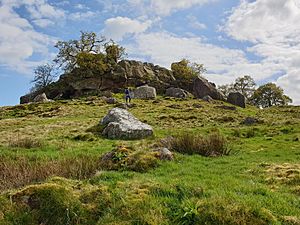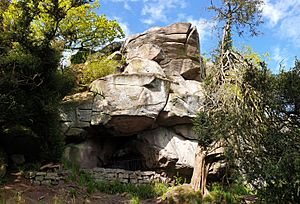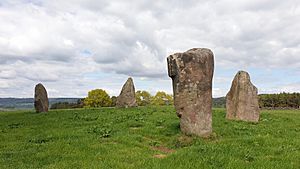Harthill Moor facts for kids
Harthill Moor is a cool upland area in the Derbyshire Peak District in central England. It's located between the towns of Matlock and Bakewell, close to the villages of Birchover and Elton. The highest point of Harthill Moor is about 272 meters (892 feet) above sea level. The River Bradford flows along the northern edge of the moor, passing by Youlgreave before joining the River Lathkill at Alport. Harthill Moor is famous for its many ancient sites from long ago, which are protected as Scheduled Ancient Monuments. This means they are important historical places that must be preserved.
Contents
Amazing Rocks and Climbing Spots
The rocks you see at Harthill Moor and nearby Stanton Moor are called Ashover Grit. This type of rock is a coarse-grained sandstone, which means it's made of rough sand particles stuck together. When this rock breaks down, it creates sandy soil.
Robin Hood's Stride
Robin Hood's Stride is a very noticeable natural rock formation. It looks like it has tall, distinct towers! People sometimes call it Mock Beggar Hall. Ancient rock art has been found on and near this gritstone outcrop. It's a popular place for bouldering, which is like climbing on big rocks without ropes. You can also do some short climbs on parts of it called Weasel Pinnacle and Inaccessible Pinnacle.
Cratcliff Rocks: More Climbing and a Hermit's Cave
Cratcliff Rocks is a large area of rocks on the edge of Harthill Moor. It offers more challenging rock climbing, with over 200 different routes for climbers to try.
Ancient Settlement at Cratcliff Rocks
Near Cratcliff Rocks, there's an ancient enclosed area called Cratcliff Rocks Defended Settlement. It's a round enclosure about 100 meters (328 feet) wide with a 5-meter (16-foot) wide ditch dug into the rock. Inside, people have found spots where buildings likely stood. Even though it hasn't been fully dug up by archaeologists, experts believe it's connected to other Bronze Age sites on Harthill Moor. The Bronze Age was a time in history when people started using bronze tools.
The Hermit's Cave
Cratcliff Rocks also has a special place called the Hermit's Cave. This was a cave used by a hermit, a person who lived alone, during the Middle Ages. Inside the rock shelter, there are small carved spaces in the walls where candles and special objects might have been placed. There's even a bas-relief (a sculpture that sticks out from a flat surface) of a crucifix carved into the cave. It's thought to be from the 13th or 14th century. Outside the cave, you can see marks on the rock face that show where a building's roof used to be attached to the cave.
Ancient Circles and Burial Mounds
Harthill Moor is home to several fascinating ancient sites, including stone circles and burial mounds.
Nine Stones Close
Nine Stones Close is a Bronze Age stone circle. It's about 30 meters (98 feet) across, and today, only four of its original upright stones remain. These stones are about 2 meters (6.5 feet) tall. Many stones were removed in the 1700s and 1800s. One stone was even taken to be used as a gatepost in a field wall nearby! Archaeologists like Thomas Bateman have done some digging here, finding many Bronze Age flints and pieces of pottery.
Other Nearby Stone Circles
About 1 kilometer (0.6 miles) east of Nine Stones Close, you'll find another stone circle called Doll Tor. And if you go another 1.5 kilometers (0.9 miles) northeast, you'll reach the Nine Ladies stone circle on Stanton Moor.
Castle Ring and Burial Mound
The Castle Ring defended settlement is just north of Harthill Moor Farm. It's an oval-shaped earthwork with a ditch about 5 meters (16 feet) wide and 100 meters (328 feet) across. It also has inner and outer banks up to 2 meters (6.5 feet) high. Like the Cratcliff Rocks settlement, it's believed to be an important part of the Bronze Age landscape here.
The Harthill Moor bowl barrow is a Bronze Age burial mound. It's about 150 meters (492 feet) southeast of Harthill Moor Farm. This mound is 20 meters (65 feet) long and 11 meters (36 feet) wide. When it was partly dug up in 1877, archaeologists found a limestone box (called a cist) with the remains of two cremations inside.
Ancient Pathways
The Derbyshire Portway
An ancient road called the Derbyshire Portway crosses Harthill Moor, running from north to south. This old route passes between Robin Hood's Stride and Cratcliff Rocks, and right past Nine Stones Close. It was once an important path connecting Mam Tor in the Peak District to the Hemlock Stone near Nottingham.
The Limestone Way
Today, a long-distance walking path called the Limestone Way follows part of the Derbyshire Portway across Harthill Moor. However, it then goes around the Castle Ring earthwork and heads towards Youlgreave.
Harthill Hall: A Historic Estate
Harthill Hall is located on the northern edge of the moor near Alport. This was once the manor of a large estate from the 13th century. The manor house from the 16th century, a farm house, and a chapel from the 14th century are still standing today. Harthill was mentioned in the Domesday Book (a famous survey from 1086) as Hortel and Hortil. It was part of the lands owned by the Norman knights Henry de Ferrers and Ralph FitzHubert.




